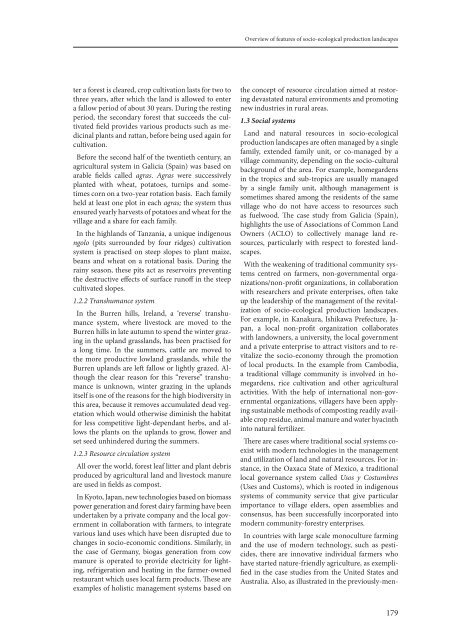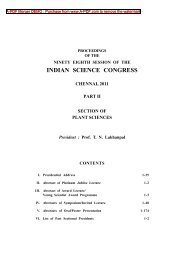sustainable use of biological diversity.pdf - India Environment Portal
sustainable use of biological diversity.pdf - India Environment Portal
sustainable use of biological diversity.pdf - India Environment Portal
Create successful ePaper yourself
Turn your PDF publications into a flip-book with our unique Google optimized e-Paper software.
Overview <strong>of</strong> features <strong>of</strong> socio-ecological production landscapes<br />
ter a forest is cleared, crop cultivation lasts for two to<br />
three years, after which the land is allowed to enter<br />
a fallow period <strong>of</strong> about 30 years. During the resting<br />
period, the secondary forest that succeeds the cultivated<br />
field provides various products such as medicinal<br />
plants and rattan, before being <strong>use</strong>d again for<br />
cultivation.<br />
Before the second half <strong>of</strong> the twentieth century, an<br />
agricultural system in Galicia (Spain) was based on<br />
arable fields called agras. Agras were successively<br />
planted with wheat, potatoes, turnips and sometimes<br />
corn on a two-year rotation basis. Each family<br />
held at least one plot in each agras; the system thus<br />
ensured yearly harvests <strong>of</strong> potatoes and wheat for the<br />
village and a share for each family.<br />
In the highlands <strong>of</strong> Tanzania, a unique indigenous<br />
ngolo (pits surrounded by four ridges) cultivation<br />
system is practised on steep slopes to plant maize,<br />
beans and wheat on a rotational basis. During the<br />
rainy season, these pits act as reservoirs preventing<br />
the destructive effects <strong>of</strong> surface run<strong>of</strong>f in the steep<br />
cultivated slopes.<br />
1.2.2 Transhumance system<br />
In the Burren hills, Ireland, a ‘reverse’ transhumance<br />
system, where livestock are moved to the<br />
Burren hills in late autumn to spend the winter grazing<br />
in the upland grasslands, has been practised for<br />
a long time. In the summers, cattle are moved to<br />
the more productive lowland grasslands, while the<br />
Burren uplands are left fallow or lightly grazed. Although<br />
the clear reason for this “reverse” transhumance<br />
is unknown, winter grazing in the uplands<br />
itself is one <strong>of</strong> the reasons for the high bio<strong>diversity</strong> in<br />
this area, beca<strong>use</strong> it removes accumulated dead vegetation<br />
which would otherwise diminish the habitat<br />
for less competitive light-dependant herbs, and allows<br />
the plants on the uplands to grow, flower and<br />
set seed unhindered during the summers.<br />
1.2.3 Resource circulation system<br />
All over the world, forest leaf litter and plant debris<br />
produced by agricultural land and livestock manure<br />
are <strong>use</strong>d in fields as compost.<br />
In Kyoto, Japan, new technologies based on biomass<br />
power generation and forest dairy farming have been<br />
undertaken by a private company and the local government<br />
in collaboration with farmers, to integrate<br />
various land <strong>use</strong>s which have been disrupted due to<br />
changes in socio-economic conditions. Similarly, in<br />
the case <strong>of</strong> Germany, biogas generation from cow<br />
manure is operated to provide electricity for lighting,<br />
refrigeration and heating in the farmer-owned<br />
restaurant which <strong>use</strong>s local farm products. These are<br />
examples <strong>of</strong> holistic management systems based on<br />
the concept <strong>of</strong> resource circulation aimed at restoring<br />
devastated natural environments and promoting<br />
new industries in rural areas.<br />
1.3 Social systems<br />
Land and natural resources in socio-ecological<br />
production landscapes are <strong>of</strong>ten managed by a single<br />
family, extended family unit, or co-managed by a<br />
village community, depending on the socio-cultural<br />
background <strong>of</strong> the area. For example, homegardens<br />
in the tropics and sub-tropics are usually managed<br />
by a single family unit, although management is<br />
sometimes shared among the residents <strong>of</strong> the same<br />
village who do not have access to resources such<br />
as fuelwood. The case study from Galicia (Spain),<br />
highlights the <strong>use</strong> <strong>of</strong> Associations <strong>of</strong> Common Land<br />
Owners (ACLO) to collectively manage land resources,<br />
particularly with respect to forested landscapes.<br />
With the weakening <strong>of</strong> traditional community systems<br />
centred on farmers, non-governmental organizations/non-pr<strong>of</strong>it<br />
organizations, in collaboration<br />
with researchers and private enterprises, <strong>of</strong>ten take<br />
up the leadership <strong>of</strong> the management <strong>of</strong> the revitalization<br />
<strong>of</strong> socio-ecological production landscapes.<br />
For example, in Kanakura, Ishikawa Prefecture, Japan,<br />
a local non-pr<strong>of</strong>it organization collaborates<br />
with landowners, a university, the local government<br />
and a private enterprise to attract visitors and to revitalize<br />
the socio-economy through the promotion<br />
<strong>of</strong> local products. In the example from Cambodia,<br />
a traditional village community is involved in homegardens,<br />
rice cultivation and other agricultural<br />
activities. With the help <strong>of</strong> international non-governmental<br />
organizations, villagers have been applying<br />
<strong>sustainable</strong> methods <strong>of</strong> composting readily available<br />
crop residue, animal manure and water hyacinth<br />
into natural fertilizer.<br />
There are cases where traditional social systems coexist<br />
with modern technologies in the management<br />
and utilization <strong>of</strong> land and natural resources. For instance,<br />
in the Oaxaca State <strong>of</strong> Mexico, a traditional<br />
local governance system called Usos y Costumbres<br />
(Uses and Customs), which is rooted in indigenous<br />
systems <strong>of</strong> community service that give particular<br />
importance to village elders, open assemblies and<br />
consensus, has been successfully incorporated into<br />
modern community-forestry enterprises.<br />
In countries with large scale monoculture farming<br />
and the <strong>use</strong> <strong>of</strong> modern technology, such as pesticides,<br />
there are innovative individual farmers who<br />
have started nature-friendly agriculture, as exemplified<br />
in the case studies from the United States and<br />
Australia. Also, as illustrated in the previously-men-<br />
179
















